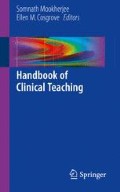Abstract
Learners differ in their preferences and aptitudes for acquiring, consolidating, and integrating new information. Similarly, teachers have a variety of preferences, strategies, and strengths for teaching. While it is conceptually attractive to imagine that simply matching “learning styles” and “teaching styles” will lead to better educational outcomes, this conclusion is not supported by the available research. Rather, understanding learning and teaching styles allows the clinical teacher to improve educational outcomes by (a) presenting information in a variety of styles and (b) troubleshoot challenging teacher-student interactions.
Access this chapter
Tax calculation will be finalised at checkout
Purchases are for personal use only
References
Cook DA, Smith AJ. Validity of index of learning styles scores: multitrait-multimethod comparison with three cognitive/learning style instruments. Med Educ. 2006;40(9):900–7.
Romanelli F, Bird E, Ryan M. Learning styles: a review of theory, application, and best practices. Am J Pharm Educ. 2009;73(1):9.
Cook DA, Thompson WG, Thomas KG, Thomas MR. Lack of interaction between sensing-intuitive learning styles and problem-first versus information-first instruction: a randomized crossover trial. Adv Health Sci Educ Theory Pract. 2009;14(1):79–90.
Shope TC, Frohna JG, Frohna AZ. Using the Myers-Briggs Type Indicator (MBTI) in the teaching of leadership skills. Med Educ. 2000;34(11):956.
Greenberg LW, Goldberg RM, Foley RP. Learning preference and personality type: their association in paediatric residents. Med Educ. 1996;30(4):307–11.
Cook DA. Reliability and validity of scores from the index of learning styles. Acad Med. 2005;80(10 Suppl):S97–101.
Briggs Meyers I. MBTI manual. Palo Alto: Consulting Psychologists; 1998.
Felder RM, Silverman L. Learning and teaching styles in engineering education [Electronic version]. Eng Educ. 1988;78(7):674–81.
Hirsh SK, Kummerow JM. Introduction to type in organizations. 3rd ed. Mountain View: CPP; 1998.
Author information
Authors and Affiliations
Corresponding author
Editor information
Editors and Affiliations
Rights and permissions
Copyright information
© 2016 Springer International Publishing Switzerland
About this chapter
Cite this chapter
Sutton, P.R., McPhillips, H.A. (2016). How to Use Learning Preferences to Optimize Teaching Effectiveness. In: Mookherjee, S., Cosgrove, E. (eds) Handbook of Clinical Teaching. Springer, Cham. https://doi.org/10.1007/978-3-319-33193-5_4
Download citation
DOI: https://doi.org/10.1007/978-3-319-33193-5_4
Published:
Publisher Name: Springer, Cham
Print ISBN: 978-3-319-33191-1
Online ISBN: 978-3-319-33193-5
eBook Packages: MedicineMedicine (R0)

